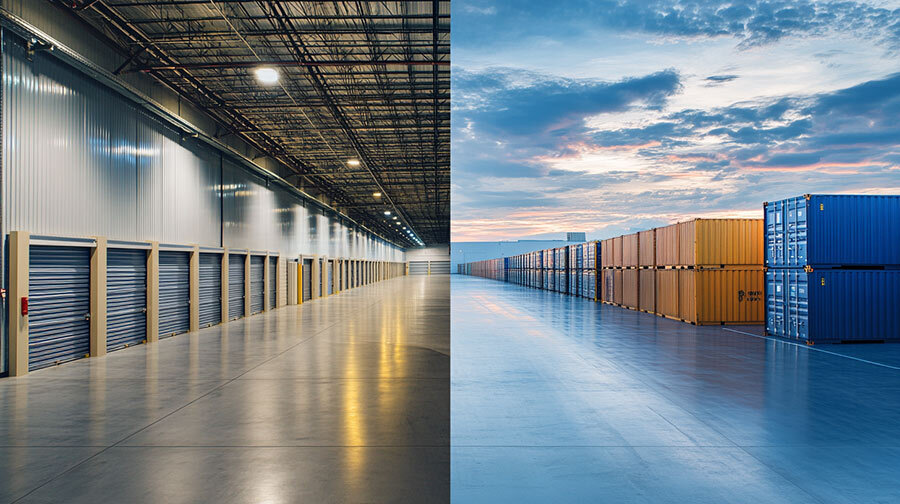As a self storage owner or investor, deciding whether to build an indoor facility or go down the outdoor container route is one of the most important early calls you'll make.
Each model has its own strengths and drawbacks. Indoor storage is typically associated with higher capital costs and a more controlled customer experience. Outdoor container storage, on the other hand, can offer faster setup and lower costs, but may come with trade-offs in perception and pricing power.
So, which one’s right for your market, budget, and business model?
Below, we explore the pros and cons of each model, detailing the different setup costs, customer expectations, and operational challenges, so you can decide which model aligns best with your business goals.
Indoor Self Storage Facilities
Pros
Higher Rental Income
Indoor self storage facilities typically command higher prices per square foot thanks to features like climate control, improved ventilation, and enhanced security. Customers are often willing to pay more for peace of mind and convenience. For example, at my own indoor facility, we’re achieving around £23 per square foot, more than double the £10 being charged at a nearby container site.
Stronger Long-Term Asset Value
Indoor facilities often appeal to more premium-seeking customers, which can lead to longer stays and greater brand loyalty. From an investment perspective, they also tend to attract higher valuations and multiples when it comes time to sell. There’s a clearer, more active market for buying and selling indoor facilities across the UK, which adds an extra layer of exit flexibility.
More Upsell Opportunities
The indoor environment creates scope to offer value-added services, such as packing materials, insurance add-ons, or business-focused offerings like document storage and shredding. This not only diversifies revenue but helps position your site as a premium, full-service option.
Enhanced Security
With a roof overhead, it’s easier to implement advanced security features, like 24/7 CCTV, PIN-coded access, and monitored alarm systems. It also gives customers more confidence when storing high-value or sensitive goods.
Cons
Higher Upfront Investment
An indoor build requires a larger initial outlay. You’re looking at costs for fit-out, partitioning, heating or cooling systems, and robust security infrastructure. When I launched StoreStuff, I took on a long-term lease on a relatively small warehouse to keep initial costs under control. We also phased the fit-out, starting with 49 units, then adding more as occupancy rose.
Higher Running Costs
Business rates, rent, utilities, cleaning, and security all add up. These ongoing expenses need to be closely managed to ensure they don’t eat too far into the higher revenue you’re aiming to generate.
Outdoor Container Storage
Pros
Lower Startup Costs
Outdoor container sites are cheaper and faster to get up and running. You don’t need to build a structure or fit out internal units. If you already own land or can lease it at a reasonable rate, your upfront investment can be minimal.
Scalability and Flexibility
Need more space? Just drop in another container. This modular approach makes outdoor storage incredibly responsive to demand and far less risky to expand gradually over time.
Low Maintenance
Containers are built to endure the elements. That durability translates into fewer repairs and reduced ongoing maintenance compared to indoor alternatives.
Cons
Lower Rental Rates
Outdoor storage tends to command lower prices, often because it lacks climate control and feels more basic. Some customers worry about condensation or damp issues, rightly or wrongly, and that affects willingness to pay. You can take steps to reduce these issues, but perception is often just as important as reality.
Perceived Security Gaps
While you can install fencing, cameras, and lighting, outdoor facilities may still be seen as less secure. A good security setup is essential to win trust, but even then, the open nature of the site can be a concern for some tenants.
Weather Exposure
Unlike indoor storage, containers don’t shield contents from the full range of weather conditions. That’s fine for many customers, but if you’re targeting those storing furniture, electronics, or paper-based goods, it’s a drawback worth considering.
Lower Resale Value
Although the cash flow from a well-run container site can be excellent, if you’re thinking long-term exit strategy, it's worth noting that outdoor facilities tend to sell at lower multiples (if they sell at all). There are fewer comparable transactions in the UK market, which can make valuations trickier and buyers harder to find.
Final Thoughts
There’s no one-size-fits-all answer here. The right choice depends on your goals, your capital, and the assets you already control, whether that’s land, a warehouse, or just market insight in your local area.
We’ve seen highly successful businesses built with both models. Indoor and outdoor each have a place in today’s storage market, it’s about choosing the route that best fits your strategy and scaling from there.








